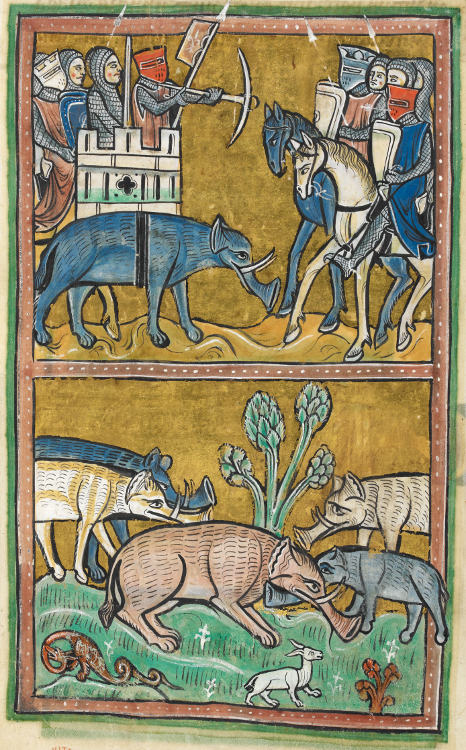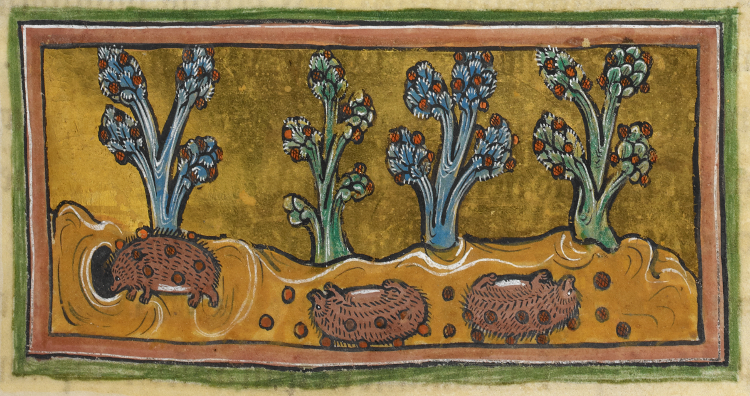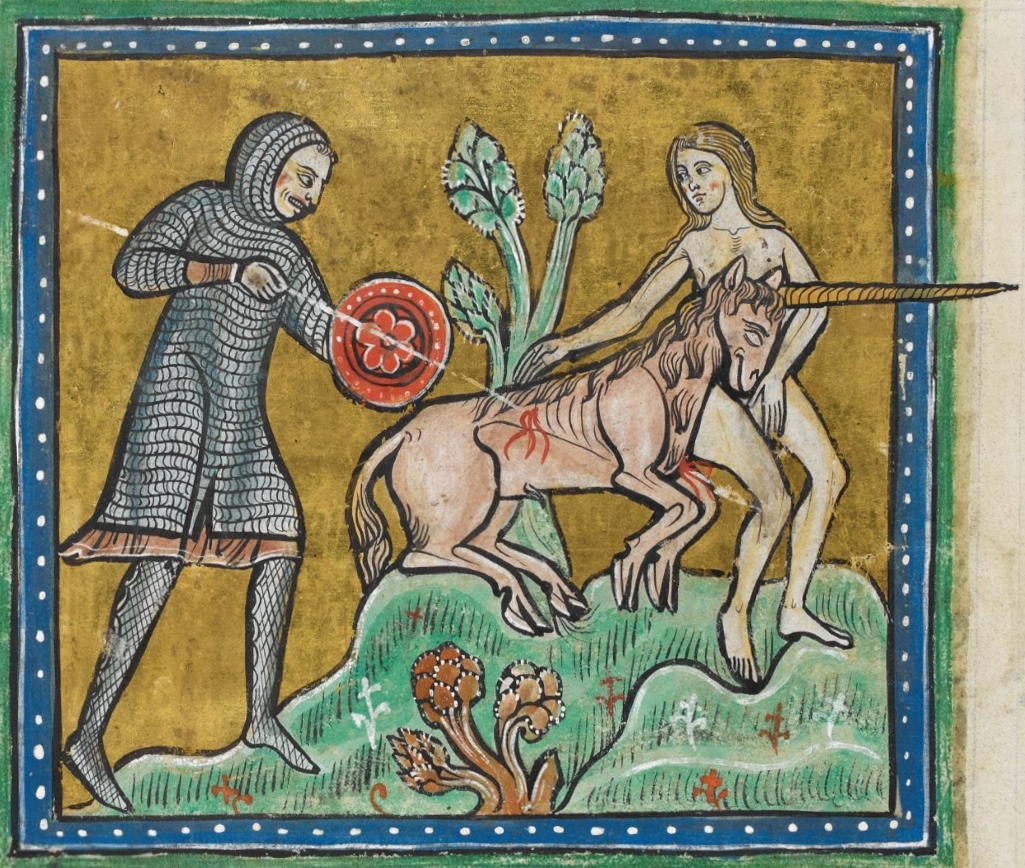Rochester Bestiary on:
[Wikipedia]
[Google]
[Amazon]
 The Rochester Bestiary
The Rochester Bestiary
London, British Library, Royal MS 12 F.xiii
is a richly illuminated manuscript copy of a medieval
 The Rochester Bestiary is a parchment manuscript dating from c. 1230–1240.Clark 2006, p. 73 Its principle contents are a bestiary, but it also contains a short lapidary (a treatise on stones) in French prose and, as the flyleaves, two leaves of a 14th-century service book.Warner and Gilson 1921, p. 64 It is illustrated with 55 finished miniatures of various animals, each at the end of the passage describing that animal.Detailed Record for Royal 12 F XIII
The Rochester Bestiary is a parchment manuscript dating from c. 1230–1240.Clark 2006, p. 73 Its principle contents are a bestiary, but it also contains a short lapidary (a treatise on stones) in French prose and, as the flyleaves, two leaves of a 14th-century service book.Warner and Gilson 1921, p. 64 It is illustrated with 55 finished miniatures of various animals, each at the end of the passage describing that animal.Detailed Record for Royal 12 F XIII
on the ''Catalogue of Illuminated Manuscripts'' On some pages, instructions to the illuminator are visible, briefly describing what the planned picture should depict. About a third of the way through the manuscript (f. 52v and following, after the vulture), the illustrations cease: while spaces remain where they were intended to be placed, no illustrations were ever added. The style of the miniatures shows some evidence that the illustrations were made as much as a decade or more after the initial production of the text, and it is possible that the artist did not fully understand the projected plan envisioned by the scribe: by adding a fourth picture of a lion, instead of the planned three, he forced subsequent illustrations to be placed after the animals they described, instead of before.Clark 2006, pp. 74–75 Three other extant manuscripts feature illuminations by this artist: Cambridge, University Library, MS. Ee.2.23 (a Bible),For a description, se
''Catalogue''
1872, II, p. 40 on the ''Internet Archive'' Peterborough, Cathedral Library, MS. 10 (a Bible), and Stockholm, National Museum, MS. B. 2010 (a psalter).Clark 2006, p. 74 A fourth manuscript (Turin, Biblioteca Nazionale, Cod. L.IV.25) contained two full-page miniatures from this artist, but was destroyed in 1904.




 The bestiary features the following animals:
#Lion
#Tiger
#Leopard
#Panther
#Antelope
#
The bestiary features the following animals:
#Lion
#Tiger
#Leopard
#Panther
#Antelope
#
Royal MS 12 F. xiii
f. 10r #Lynx #
on ''The Medieval Bestiary'' # Dipsa (a snake whose venom is so poisonous, it kills before the victim perceives the bite)"Dipsa"
on ''The Medieval Bestiary'' #
on ''The Medieval Bestiary'' A French-language lapidary follows directly on the Latin description of fire stones, giving further descriptions of a large number of stones, including the magnet, coral, carnelian, ceraunius (the "thunder-stone"), crystal, and many others.
Full photographic reproduction of Royal MS 12 F.xiii
from the British Library Digitised Manuscripts website 13th-century illuminated manuscripts Bestiaries British Library Royal manuscripts
 The Rochester Bestiary
The Rochester BestiaryLondon, British Library, Royal MS 12 F.xiii
is a richly illuminated manuscript copy of a medieval
bestiary
A bestiary (from ''bestiarum vocabulum'') is a compendium of beasts. Originating in the ancient world, bestiaries were made popular in the Middle Ages in illustrated volumes that described various animals and even rocks. The natural history ...
, a book describing the appearance and habits of a large number of familiar and exotic animals, both real and legendary. The animals' characteristics are frequently allegorised, with the addition of a Christian moral.
The bestiary tradition
The medievalbestiary
A bestiary (from ''bestiarum vocabulum'') is a compendium of beasts. Originating in the ancient world, bestiaries were made popular in the Middle Ages in illustrated volumes that described various animals and even rocks. The natural history ...
ultimately derives from the Greek-language ''Physiologus
The ''Physiologus'' () is a didactic Christian text written or compiled in Greek by an unknown author, in Alexandria; its composition has been traditionally dated to the 2nd century AD by readers who saw parallels with writings of Clement of A ...
'', a text whose precise date and place of origin is disputed, but which was most likely written in North Africa sometime in the second or third century.McCulloch 1960, p. 18 The ''Physiologus'' was translated into Latin
Latin (, or , ) is a classical language belonging to the Italic languages, Italic branch of the Indo-European languages. Latin was originally a dialect spoken in the lower Tiber area (then known as Latium) around present-day Rome, but through ...
several times, at least as far back as the eighth century, the date of the first extant manuscripts, and likely much earlier, perhaps the fourth century.McCulloch 1960, pp. 21–22 While the earliest Latin translations were extremely faithful to their Greek source, later versions adapted more freely, particularly by the inclusion of additional information from other sources, including Pliny's ''Historia naturalis'', and, most significantly, Isidore of Seville's ''Etymologies''.McCulloch 1960, pp. 22, 28–29 The most important of the Latin ''Physiologus'' translations — the one now known by scholars as the "B Version" — was expanded even further in the twelfth century (most likely in the 1160s or 1170s), with more additions from Isidore, to become the so-called "Second Family" standard form of what now may be properly termed as the bestiary.McCulloch 1960, pp. 34–35Clark 2006, p. 27 This text was much longer than the original ''Physiologus'' and included in its typical format over 100 sections, distributed among nine major divisions of varying size. The first division included 44 animals or beasts and the second 35 birds, followed by a large division on different varieties of snakes, and divisions on worms, fish, trees, precious stones, and the nature and ages of man.McCulloch 1960, pp. 37–39 Manuscripts from this most familiar version of the bestiary were produced from the twelfth to sixteenth centuries, with most dating from the thirteenth century.Clark and McMunn 1989, p. 199
Manuscript description
 The Rochester Bestiary is a parchment manuscript dating from c. 1230–1240.Clark 2006, p. 73 Its principle contents are a bestiary, but it also contains a short lapidary (a treatise on stones) in French prose and, as the flyleaves, two leaves of a 14th-century service book.Warner and Gilson 1921, p. 64 It is illustrated with 55 finished miniatures of various animals, each at the end of the passage describing that animal.Detailed Record for Royal 12 F XIII
The Rochester Bestiary is a parchment manuscript dating from c. 1230–1240.Clark 2006, p. 73 Its principle contents are a bestiary, but it also contains a short lapidary (a treatise on stones) in French prose and, as the flyleaves, two leaves of a 14th-century service book.Warner and Gilson 1921, p. 64 It is illustrated with 55 finished miniatures of various animals, each at the end of the passage describing that animal.Detailed Record for Royal 12 F XIIIon the ''Catalogue of Illuminated Manuscripts'' On some pages, instructions to the illuminator are visible, briefly describing what the planned picture should depict. About a third of the way through the manuscript (f. 52v and following, after the vulture), the illustrations cease: while spaces remain where they were intended to be placed, no illustrations were ever added. The style of the miniatures shows some evidence that the illustrations were made as much as a decade or more after the initial production of the text, and it is possible that the artist did not fully understand the projected plan envisioned by the scribe: by adding a fourth picture of a lion, instead of the planned three, he forced subsequent illustrations to be placed after the animals they described, instead of before.Clark 2006, pp. 74–75 Three other extant manuscripts feature illuminations by this artist: Cambridge, University Library, MS. Ee.2.23 (a Bible),For a description, se
''Catalogue''
1872, II, p. 40 on the ''Internet Archive'' Peterborough, Cathedral Library, MS. 10 (a Bible), and Stockholm, National Museum, MS. B. 2010 (a psalter).Clark 2006, p. 74 A fourth manuscript (Turin, Biblioteca Nazionale, Cod. L.IV.25) contained two full-page miniatures from this artist, but was destroyed in 1904.
History of the manuscript
The manuscript is usually assumed to have been made at St. Andrew's Priory atRochester Cathedral
Rochester Cathedral, formally the Cathedral Church of Christ and the Blessed Virgin Mary, is an English church of Norman architecture in Rochester, Medway, Rochester, Kent.
The church is the cathedral of the Diocese of Rochester in the Church o ...
. An inscription places the book there with certainty in the fourteenth century. At some point, it appears that the book was stolen from the priory, as another fourteenth-century inscription notes its return by a "brother John Malling," who may have been the culprit: a man named John Malling was excommunicated in 1387 as an apostate and thief.Warner and Gilson 1921, p. 65 By 1542 it was in the possession of the king, as it is listed in an inventory of the royal library at Westminster in that year. King George II donated it, together with the rest of the Old Royal Library
The Royal manuscripts are one of the "closed collections" of the British Library (i.e. historic collections to which new material is no longer added), consisting of some 2,000 manuscripts collected by the sovereigns of England in the "Old Royal ...
, to the British Museum
The British Museum is a public museum dedicated to human history, art and culture located in the Bloomsbury area of London. Its permanent collection of eight million works is among the largest and most comprehensive in existence. It docum ...
in 1757, and it is now at the British Library
The British Library is the national library of the United Kingdom and is one of the largest libraries in the world. It is estimated to contain between 170 and 200 million items from many countries. As a legal deposit library, the Briti ...
.
Adaptation of the text in the Rochester manuscript
Additions to the standard bestiary text have been made in the Rochester Bestiary by drawing from Part IV of the ''Pantheologus'' by Peter of Aldgate. A complete copy of the ''Pantheologus'', now extant as British Library, Royal MS. 7 E.viii, was located in Rochester in the early 13th century, and may have been the direct source for the bestiary additions.The animals




 The bestiary features the following animals:
#Lion
#Tiger
#Leopard
#Panther
#Antelope
#
The bestiary features the following animals:
#Lion
#Tiger
#Leopard
#Panther
#Antelope
#Unicorn
The unicorn is a legendary creature that has been described since antiquity as a beast with a single large, pointed, spiraling horn projecting from its forehead.
In European literature and art, the unicorn has for the last thousand years o ...
("which is called 'rhinoceros' by the Greeks")British LibraryRoyal MS 12 F. xiii
f. 10r #Lynx #
Griffin
The griffin, griffon, or gryphon ( Ancient Greek: , ''gryps''; Classical Latin: ''grȳps'' or ''grȳpus''; Late and Medieval Latin: ''gryphes'', ''grypho'' etc.; Old French: ''griffon'') is a legendary creature with the body, tail, and ...
#Elephant
#Beaver
#Ibex
#Hyena
#Bonasus (an Asian animal with a bull's head and curling horns)McCulloch 1960, p. 98
#Ape
#Satyr
In Greek mythology, a satyr ( grc-gre, σάτυρος, sátyros, ), also known as a silenus or ''silenos'' ( grc-gre, σειληνός ), is a male nature spirit with ears and a tail resembling those of a horse, as well as a permanent, ex ...
#Stag
#Goat
#She-goat
#Monocerus
The monoceros ( el, μονόκερως) is a legendary animal with only one horn related to the unicorn.
Mythology
It derives from the Greek word μονόκερως (''monokerōs''), a compound word from μόνος (''monos'') which means "onl ...
#Bear
# Leucrota (an Indian animal with the body of a lion and the head of a horse)McCulloch 1960, p. 136
#Crocodile
# Manticore (an Indian animal with the face of a man and the body of a lion)McCulloch 1960, p. 142
#Parandrus
A tarand, also known as a tarandos, tarandus, parandrus, or parandros, is a legendary reindeer/ moose-like creature with chameleon properties. It was first described in
Aristotle's Corpus Aristotelicum as Tarandos (Τάρανδος).
It was also ...
(an Ethiopian animal sometimes identified as a reindeer or elk)McCulloch 1960, p. 150
#Fox
#Yale
Yale University is a private research university in New Haven, Connecticut. Established in 1701 as the Collegiate School, it is the third-oldest institution of higher education in the United States and among the most prestigious in the wor ...
(an animal with the tail of an elephant and the jaws of a goat)McCulloch 1960, pp. 190–91
#Wolf
#Dog
#Sheep
#Ram (male sheep) and wether (castrated male sheep)
#Lamb
#He-goat and kid
#Boar
#Bull
#Ox and wild ox
#Camel
#Dromedary
#Ass
#Onager (wild ass)
#Horse
#Cat
#Mouse
#Weasel
#Mole
#Hedgehog
#Ant
#Eagle
#Vulture
#Crane
#Parrot
#Caladrius
The caladrius, according to Roman mythology, is a snow-white bird that lives in the king's house. It is said to be able to take the sickness into itself and then fly away, dispersing the sickness and healing both itself and the sick person. The ...
(a white bird capable of predicting the outcome of an illness)McCulloch 1960, pp. 99–101
#Swan
#Stork
#Ibis
#Coot
Coots are medium-sized water birds that are members of the rail family, Rallidae. They constitute the genus ''Fulica'', the name being the Latin term for "coot". Coots have predominantly black plumage, and—unlike many rails—they are usually ...
#Ostrich
#Kingfisher
#Heron
#Goose
#Horned owl
#Small owl or night raven
#Phoenix
Phoenix most often refers to:
* Phoenix (mythology), a legendary bird from ancient Greek folklore
* Phoenix, Arizona, a city in the United States
Phoenix may also refer to:
Mythology
Greek mythological figures
* Phoenix (son of Amyntor), a ...
# Cinnamolgus (an Arabian bird that nests in the cinnamon tree)McCulloch 1960, pp. 103–104
# Hercinia (a German bird that glows in the dark)McCulloch 1960, p. 125
#Hoopoe
Hoopoes () are colourful birds found across Africa, Asia, and Europe, notable for their distinctive "crown" of feathers. Three living and one extinct species are recognized, though for many years all of the extant species were lumped as a single ...
#Pelican
#Siren
Siren or sirens may refer to:
Common meanings
* Siren (alarm), a loud acoustic alarm used to alert people to emergencies
* Siren (mythology), an enchanting but dangerous monster in Greek mythology
Places
* Siren (town), Wisconsin
* Siren, Wiscon ...
(half-human, half-bird)
#Partridge
#Quail
#Magpie and woodpecker
#Hawk
#Gull
#Tawny owl
#Bat
#Raven
#Crow
#Dove
#Turtledove
#Tern
#Peacock
#Cock
#Hen
#Duck
#Bee
# Peridexion tree (an Indian tree whose shadow frightens dragons)McCulloch 1960, pp. 157–58
#Asp
#Dragon
#Basilisk
In European bestiaries and legends, a basilisk ( or ) is a legendary reptile reputed to be a serpent king, who causes death to those who look into its eyes. According to the '' Naturalis Historia'' of Pliny the Elder, the basilisk of Cyre ...
(the "king of serpents," since it can kill other serpents with its odor)McCulloch 1960, p. 93
#Viper
# Scitalis (a snake that can hypnotize with its shining back)McCulloch 1960, p. 165
#Amphisbaena
The amphisbaena (, , or , plural: amphisbaenae; grc, ἀμφίσβαινα) is a mythological, ant-eating serpent with a head at each end. The creature is alternatively called the amphisbaina, amphisbene, amphisboena, amphisbona, amphista, amf ...
(a snake with two heads)McCulloch 1960, p. 81
#Hydrus
Hydrus is a small constellation in the deep southern sky. It was one of twelve constellations created by Petrus Plancius from the observations of Pieter Dirkszoon Keyser and Frederick de Houtman and it first appeared on a 35-cm (14 in) d ...
(a sea serpent that, when swallowed by a crocodile, bursts out of its stomach, killing it)McCulloch 1960, pp. 129–30
# Jaculus (a winged serpent)McCulloch 1960, p. 135
#Boa
#Siren serpent (a winged serpent from Arabia)McCulloch 1960, pp. 169–70
# Seps (a snake whose venom dissolves the bones as well as flesh of its prey)"Seps"on ''The Medieval Bestiary'' # Dipsa (a snake whose venom is so poisonous, it kills before the victim perceives the bite)"Dipsa"
on ''The Medieval Bestiary'' #
Salamander
Salamanders are a group of amphibians typically characterized by their lizard-like appearance, with slender bodies, blunt snouts, short limbs projecting at right angles to the body, and the presence of a tail in both larvae and adults. All t ...
#Saura lizard (a lizard that renews its eyesight by looking at the sun)McCulloch 1960, pp. 140–41
#Gecko
#Snake
#Scorpion
#Various types of "worm", including the spider, the locust, the flea, etc.
#Various types of "fish", including the whale, the dolphin, the crocodile, the sea urchin, and other sea animals
#Various types of trees, including the palm, the laurel, the fig, the mulberry, etc.
#Long section on the nature of man and the parts of the human body
#Fire stones (which ignite when brought together)"Fire Stones"on ''The Medieval Bestiary'' A French-language lapidary follows directly on the Latin description of fire stones, giving further descriptions of a large number of stones, including the magnet, coral, carnelian, ceraunius (the "thunder-stone"), crystal, and many others.
Notes
References
* * * * * * * *{{cite book , last1=Warner , first1=George , last2=Gilson , first2=Julius , title=Catalogue of Western Manuscripts in the Old Royal and King's Collections , publisher=British Museum , location=London , year=1921 , pages=64–65 , volume=2External links
Full photographic reproduction of Royal MS 12 F.xiii
from the British Library Digitised Manuscripts website 13th-century illuminated manuscripts Bestiaries British Library Royal manuscripts